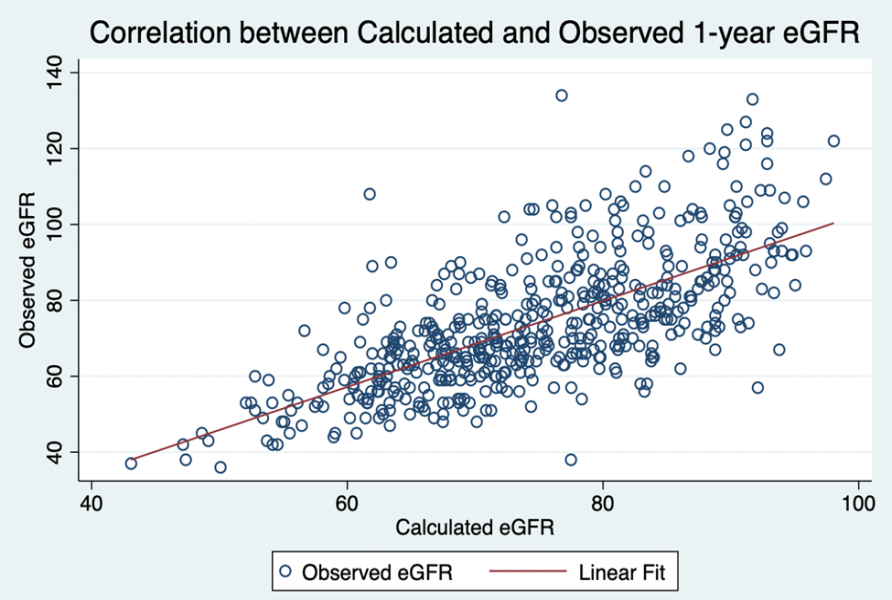Validation of the Toulouse-Rangueil eGFR12 model in a racially diverse retrospective cohort
Franco Cabeza Rivera1, Daniel Del Castillo Rix2, Adriana Medina5, Rojin Esmail5, Veronica Ortigosa Serrano6, Adela Mattiazzi1, Mahmoud Morsi3, Rodrigo Vianna 4, Gaetano Ciancio3, Giselle Guerra1.
1Division of Nephrology and Hypertension, University of Miami Miller School of Medicine, Miami, FL, United States; 2Department of Medicine, University of Miami Miller School of Medicine, Miami, FL, United States; 3Division of Kidney-Pancreas Transplantation, Department of Surgery, Miami Transplant Institute, University of Miami/Jackson Memorial Hospital, Miami, FL, United States; 4Department of Surgery, Liver and Gastrointestinal Transplantation, Miami Transplant Institute, University of Miami/Jackson Memorial Hospital, Miami, FL, United States; 5Ross University School of Medicine, Bridgetown, Barbados; 6Hospital Beneficent São Carlos, Rio Grande do Sul, Brazil
Introduction: The Toulouse-Rangueil model (TRM), was designed to predict a 1-year post-donation glomerular filtration rate (eGFR) and the risk of chronic kidney disease (CKD) development among donors. Our study uses the 2021 Chronic Kidney Disease Epidemiology Collaboration (CKD-EPI) formula to validate the TRM within a racially diverse American cohort. This effort seeks to extend the model's applicability, contribute to accurate risk assessments for all potential living kidney donors, and ensure a comprehensive understanding of post-donation outcomes.
Methods: We retrospectively reviewed the clinical data of seven hundred ninety-one donors who underwent nephrectomy for living donor kidney transplantation at the Miami Transplant Institute from 2011 to 2021. The observed eGFR calculated with the 2021 CKD-EPI formula one year after donation was evaluated against the predictive model of eGFR determined using TRM at one-year post-donation to evaluate the predictive ability of the formula through descriptive statistics, Pearson correlation, and ROC curve analysis. Statistical significance was set at a p-value <0.05, with analyses performed using STATA/BE, version 17.
Results: Seven hundred ninety-one donors were included: 62.8% females, 34% Caucasian, 19.6% African Americans, 43.8% Hispanics, and 2.5% from other racial groups. A good correlation (Pearson r = 0.693; p < 0.001) was observed between predicted and observed 1-year post-donation eGFR (Figure 1). The area under the ROC curve (Figure 2) showed good discriminative ability of the formula in predicting observed CKD at 1-year post-donation (AUC = 0.83; p <0.001). Sensitivity and specificity for predicting CKD stages 3-5 were 21.4% and 89%, respectively.
Conclusion: The validation of the TRM within our cohort using the 2021 CKD-EPI equation demonstrated a positive correlation between predicted and observed post-donation eGFR. This is consistent with previously reported validations through similar ROC curve performances with other international cohorts. However, this study noted a distinct difference in sensitivity compared to previous analyses, indicating a lower ability of this model to detect true cases of moderate CKD within our population. By predicting eGFR using the TRM, our results underscore the need for ongoing validation and adjustment to predict clinical outcomes leading to equitable healthcare practices in a racially diverse population in the US.


[1] Living Donation
[2] Kidney Donation
[3] Donor Cohort
[4] Donor Outcome
[5] Predictive Model
[6] Living Kidney Donation
